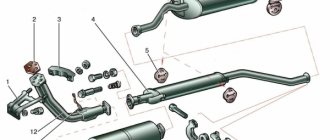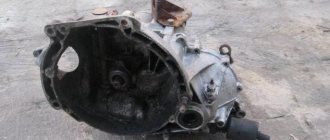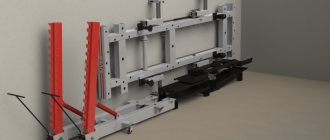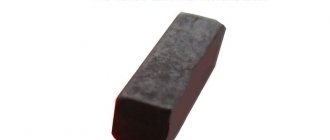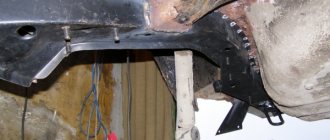Pneumatic tires on car wheels appeared in 1895. Tires with tubes have been used for a long time. At the end of the 20th century, tubeless tires, which have a number of advantages, became widespread. Currently, manufacturers install just such tires on the wheels of their cars.
Modern automobile tires have high strength and a number of other positive qualities that increase the stability and controllability of the car on the road. However, as a result of wear or puncture, they become unusable and then tire repair is needed.
Benefits of repairing tires using a harness
The main advantage of this method is the possibility of repairs in any conditions, including right on the road. An inexperienced driver can handle it; no special skills are required.
The repair kit takes up little space in the car. You can place it in the glove compartment. This is another plus.
Particular attention should be paid to the types of damage that can be repaired in this way. If the tire has a tube installed, the reinstatement tourniquet cannot be used. Cuts in the sidewall and tread cannot be repaired. Sidewall punctures cannot always be repaired with a tourniquet yourself; you need to look at the specifics of the damage.
The harness is also useless if the tire is depressurized. This can happen in the event of a strong and sharp impact on the wheel, for example, hitting an obstacle. In this case, only replacing the wheel will help. It is almost impossible to inflate a tire knocked off a hump without a special compressor.
Difference by type of construction
A mandatory attribute of tire marking is the designation of the type of construction, which is divided into two groups depending on the structure of the textile threads that provide the strength of the carcass:
- Radial - These tires are installed on most modern cars. Due to the fact that the carcass threads on them run from rim to rim, manufacturers continue to experiment with the number of layers. Even now, radial tires hold their shape much better than bias-ply tires. Thanks to high-quality clutch, controllability remains at a high level even when the vehicle is operated in difficult climatic conditions. The main disadvantage is that after a puncture, a radial tire must be disposed of and only in rare cases, with minor damage, can it be used as a spare tire.
- Diagonal - The tire has extremely strong sidewalls, which reduces the risk of damaging the wheel with a puncture. In addition, even if the wheel has been punctured, it remains quite suitable for repair.
Only by determining the type of tire on your car can you decide on the repairability of the design.
Types of harnesses for tire repair
There are different types of harnesses, they differ in features and technical characteristics.
- Rubber. The simplest option. Consists of raw rubber, sometimes self-vulcanizing rubber is used. When using, you need to be careful; the tourniquet breaks easily.
- Cordovy. Contains cord, synthetic thread. As a result, it is possible to achieve a high level of strength. The cord allows you to repair truck tires.
- Nylon. Expensive type of tourniquet. It is rare and provides a high level of reliability.
When choosing a repair kit, it is optimal to choose options with a cord harness. It is inexpensive and provides effective repairs. Nylon harness is expensive; often it will be cheaper to visit a tire shop.
Another point is the thickness of the harness. The following options are available for sale:
- 3 millimeters;
- 4.5 millimeters;
- 6 millimeters.
The best option would be to use the thickest consumable.
Sometimes you can find patch fungi in repair kits. This “fungus” allows you to seal not only punctures, but also small cuts. Such patches are called “anchors”; the main disadvantage is the high price.
What is included in the repair kit
Let's look at what a standard tire repair kit consists of.
- Awl. Has an eyelet at the end. Designed to pull the tourniquet into the damage. Sometimes it may be necessary to pierce a more even hole.
- Rasp. Can be straight or screw. With its help, the puncture is widened and cleaned.
- Glue. Provides connection between the harness and the tire rubber. Sometimes it may be absent, in which case the rubber used in the consumables of the kit is self-vulcanizing.
- Rubber band. May have different thickness.
The above is a standard set. The manufacturer can optionally add various devices to make it easier to repair a tire with his own hands.
Using sealant
The second method of repairing a tubeless tube with your own hands is carried out using special sealants in the form of a spray. We buy a can of this product at the market (the kit includes a tube with a tip for screwing onto a nipple) and take it with us. Please note that you should only purchase products from well-known brands, otherwise a low-quality sealant will not cope with the task.
Video: Testing tire sealant! Repairing a punctured wheel on the road.
The puncture is sealed with sealant as follows: first, remove the element that punctured the tire (if it is not visible, then there is no need to look for the hole). Next, the damaged wheel must be jacked up. Using a tube with a tip, we connect the can with the nipple. We inject all the available sealant inside the tire, and then rotate the wheel several times so that the sealant spreads evenly over the inner surface. We wait a couple of minutes for the product to fill the hole and thicken, thereby plugging the existing hole.
How to repair a tire with a DIY harness
Having figured out the completeness of the “first aid kit”, let’s see how to use this set. First you need to ensure safety. The car must be parked on level ground, be sure to set the handbrake. Before work, you need to inflate the tire.
Repairing a tire with a harness occurs in the following order.
- It is necessary to find a puncture. Wet the protector generously with soapy water or other viscous liquid. You can use windshield washer fluid. We determine the puncture by the bubbles that stand out. If a nail or other object has pierced the tire, the rubber does not need to be wetted.
- Use a rasp to widen the puncture. We clean it thoroughly. The better the work is done, the better the repair will be.
- We thread the cord rope through the eye of the awl.
- Lubricate the harness with glue. This should be done immediately before repairs.
- We drag the tourniquet with an awl inside the tire. We remove the awl; the rubber should fill the damage.
Cut off excess rubber. The work is completed.
Repair work
After the tools have been prepared and the puncture site has been identified, the repair should begin directly.
Tire repair using harnesses
The described steps are only valid for tubeless tires. If you repair tires equipped with a tube in this way, it will not bring the desired result.
The algorithm for repairing a tubeless tire is as follows:
- Removing dirt from the damaged area. After cleaning the area that requires repair, you can visually detect the puncture. In addition, the repair process itself will be more efficient and comfortable. It is also important to pay attention to the diameter of the puncture; if it is less than 5 mm, then the tourniquet can help create a patch; if the hole is too large, then you will have to go to a service center.
A large puncture can be repaired with several tourniquets. This measure does not imply further long-term use of the tire, but will allow you to get to the nearest service station. There, specialists will install a special “fungus” into the tire, which will completely seal the damaged tire.
- Reducing tire pressure to 0.5 atmospheres . In this way, the tension will be relieved from the structure, and the cord will retain its shape. Next, you will need to insert a “corkscrew” into the puncture, twist it and remove it. The operation must be repeated 2-3 times.
- Harness insertion . Before performing the operation, the tourniquet is coated with glue or paste. Afterwards, it is inserted using a special device. At the end of the operation, you only need to carefully trim the excess ends of the tourniquet.
The harness has virtually no weight, so after installing the “harness” patch, there is no need to balance the wheel.
- Examination. The patch area must be treated with a special aerosol or soap solution. If air bubbles appear on the surface, the above steps will have to be repeated. If everything is in order, then all that remains is to inflate the tire to an acceptable condition and you can confidently use it until it wears out.
Repair with sealant
However, a puncture is not the only reason for a tire to leak air. It can occur due to deformation of the wheel rim or corrosion. In the first case, you will need to go to a service center, where they will align the wheel rim (the wheel can be aligned with the power of a hammer, although this method is a temporary measure). If the disc is damaged by corrosion, the tire should be removed and the junction of the disc rim and tire should be treated with sealant.
Stamped steel wheels are quite cheap, so buying a new wheel will be much more profitable. If the cast disk has been damaged, it can be restored in a workshop.
Side cut
The malfunction is practically beyond repair. A small side cut can be vulcanized - repairs are carried out in a specially equipped workshop. For larger cuts, a temporary patch can be installed. Using a harness in this case is ineffective, since the side surface of the tire is made of thin rubber. When repairing a side cut, cord cutting is often used; after such repair, the tire can last for several years, or it may burst at the first serious load. Some “masters” insert a tube into a tubeless tire, but due to the rapid heating of the air, it can burst.
Even after the most reliable repair, a tire with a side cut will need to be replaced with a new one.
Other faults
The list of other malfunctions that may occur with the tire includes problems with the nipple and spools. In both the first and second cases, these components of the tubeless tire will need to be replaced, which is performed by professionals at a service center.
The spool may leak air due to dirt accumulated inside. To do this, use short and sharp movements to press the spool. Contamination can be eliminated, and the part will no longer allow air to pass through. However, a more reliable way to solve the problem is still to buy a new part.
Do I need to go to a tire shop?
Some drivers believe that after such repairs it is necessary to visit a tire shop and carry out a full repair. In fact, a tubeless tire is restored quickly and reliably in this way. The tire then lasts for a very long time.
Literally after 10-20 kilometers, the tire takes on its original appearance; it is impossible to determine where the damage was. The service life is not reduced. You can use the car without restrictions. Knowing how to make repairs yourself, you can save time on visiting a car service center.
Repairing a tire using a rubber band is a simple and reliable repair method. You need to know what repair kits are available and choose the most suitable one for your case.
Choosing the right sealant
The range of tire sealants offered on the car market is large; if you want to choose quality products, consider the following nuances:
- The temperature range in which the sealant operates. There are sealants that can crystallize at low temperatures. In winter, they become useless as they completely lose their properties. The operating temperature range can be found in the instructions supplied with the sealant.
- Purpose. There are sealants that eliminate punctures and products that have an additional function - increasing the pressure inside tires. The former are sold in plastic bottles, the latter in aerosol cans. Puncture repair products in aerosol cans are more effective and convenient to use; they perform two functions:
- eliminate punctures;
- increase the air density inside the tires.
This characteristic must be taken into account so that the tire does not burst due to excess pressure.
- Bottle volume. A sealing spray with a volume of up to 300 ml will eliminate a puncture in a small car tire, but will not be able to repair the tires of an SUV. Consider the size of the tires; the maximum parameters of rubber that can be restored with a certain product are indicated in the instructions or on the packaging of the sealant. The volume of a standard bottle is designed to repair up to 6 damages.
- Tire type. There are sealing agents intended for such products:
- tubeless wheels;
- wheels with cameras;
- universal.
- Number of punctures. Sealants can eliminate several punctures at the same time (up to 6 pieces).
- Puncture size. Sealant manufacturers indicate the size of the punctures. Please note: there are no sealants that can eliminate damage larger than 1 cm.
When buying a sealant, pay attention to possible difficulties associated with its use:
- Short duration of the recovery effect. You cannot constantly drive on a restored wheel; sealants for repairing punctures are used to get to the tire shop. They allow you to drive an additional 10 km on reconditioned tires at a speed not exceeding 50 km/h. Driving at higher speed limits is unsafe.
- Using these means, only the tread can be repaired; lateral damage cannot be eliminated.
- You should not use sealing agents if the wheel is deformed.
- There are aerosol sealants that contain flammable gases. When using them, you should not pump up the wheels with air for your own safety.

